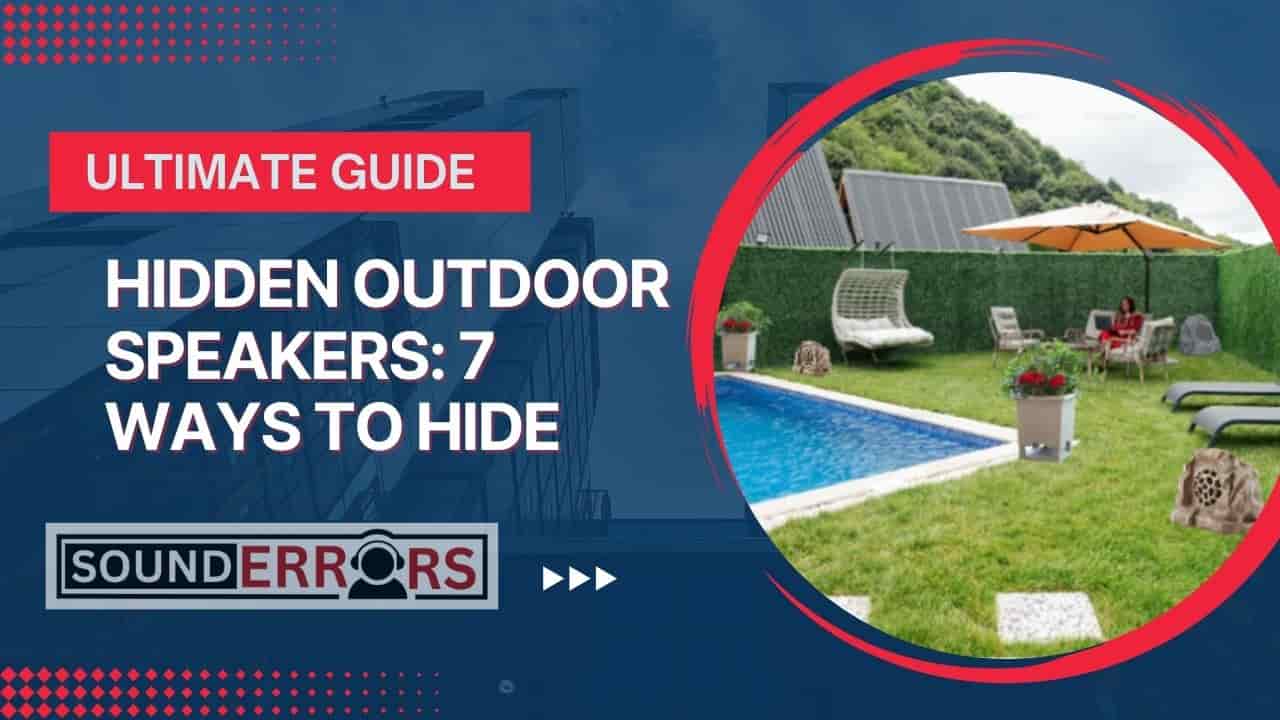This Post may contain affiliate links, when you purchase through links on our site, we may earn an affiliate commission at no extra cost to you. Here’s how it works.
With creativity and planning, you can enjoy great sound while maintaining a clean, beautiful outdoor space. However, for any innovation, there are concerns: Can hiding speakers reduce audio quality? And how can you hide the wires while maintaining good connectivity?
Table of Contents
ToggleFrom rock and planter speakers to integrated designs like furniture and lighting, you can achieve an outdoor sound system that doesn’t interrupt the aesthetics of your space.
Type of Hidden Outdoor Speakers
Hidden outdoor speakers are designed to blend into your outdoor environment without visible presence. These speakers come in various forms, such as:
- Rock Speakers: Shaped like natural rocks.
- Planter Speakers: Speakers that double as planters.
- In-wall or In-ceiling Speakers: Mounted within walls, ceilings, or other structures.
- Subwoofer/Seating Area Speakers: Often hidden underground or within seating areas.
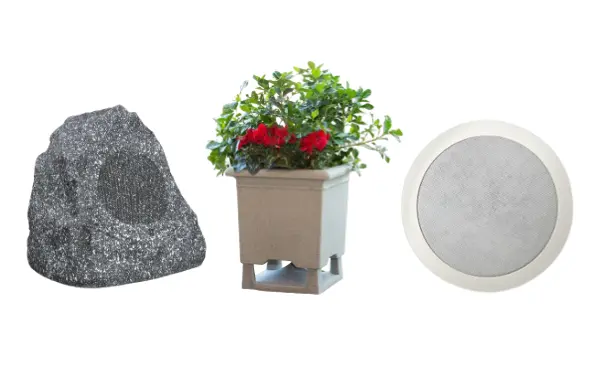
Advantages of Hidden Outdoor Speakers
- Aesthetics: Hidden speakers provide a clean, minimalist look, preserving the beauty of your outdoor space.
- Space Saving: They can be cleverly integrated into existing trees, rocks, or walls.
- Safety: This can reduce weather damage, theft, or accidental damage from foot traffic.
Ways to Hide Outdoor Speakers
When setting up outdoor speakers, you often don’t want them to dominate the visual appeal of your garden or backyard. The solution? Creative ways to hide outdoor speakers while ensuring they still perform well.
1. Rock Speakers
Best For: Gardens, Lawns, and Outdoor Pathways
Rock speakers are one of the most common methods for hiding outdoor speakers while maintaining great sound quality. These speakers are molded to look like natural rocks.
- How It Works: Rock speakers come in various shapes and sizes, mimicking actual stones or boulders. They are typically weatherproof and come with built-in drivers.
- Installation: Place the speaker where it naturally blends in with your landscape.
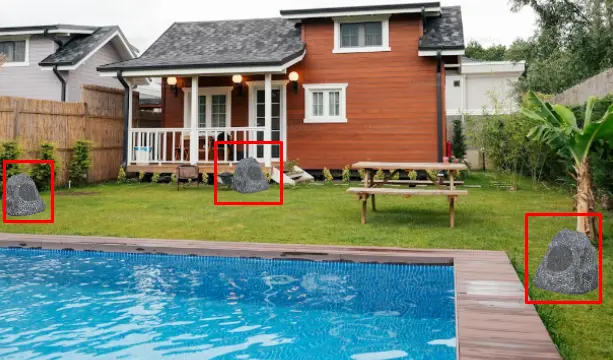
- Pros:
- Aesthetically blends well with landscaping.
- Durable and weather-resistant.
- Some wireless make installation easier.
- Cons:
- Limited bass response compared to traditional outdoor subwoofers.
- A person can damage it without knowing what it is.
2. Planter Speakers
Best For: Patios, Decks, and Balcony Gardens
Planter speakers are a hybrid solution, functioning both as planters and as speakers. These can be placed around your outdoor space, helping them disappear.
- How It Works: Planter speakers are designed to hold real plants while integrating a speaker system inside the structure. The audio drivers are embedded.
- Installation: Place the planter where plants thrive, like beside your porch or near garden beds. Ensure not attached to the wall.
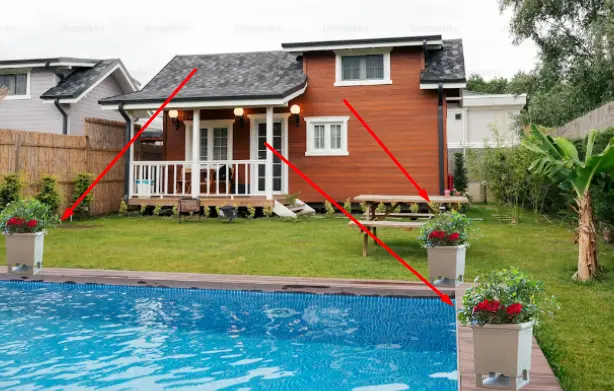
- Pros:
- Perfect for adding greenery to your outdoor space.
- Dual functionality as both a speaker and a plant container.
- Natural camouflage.
- Cons:
- Potential blockage of sound if plants or soil obstruct the speaker.
- Requires maintenance to keep plants healthy.
3. In-Wall or In-Ceiling Speakers
Best For: Outdoor Structures (Pergolas, Gazebos, Pool Houses)
In-wall or in-ceiling speakers are installed directly into the structure of your outdoor space. This has been one of the popular outdoor sound solutions for decades.
- How It Works: These speakers are built into the wall or ceiling with only the grille visible. Some models are fully weatherproof and ideal for porches, pergolas, and pool houses.
- Installation: Professional installation is required, as holes need to be cut into walls or ceilings to mount the speakers. Wiring must be routed through the structure, wireless speakers could be easier.
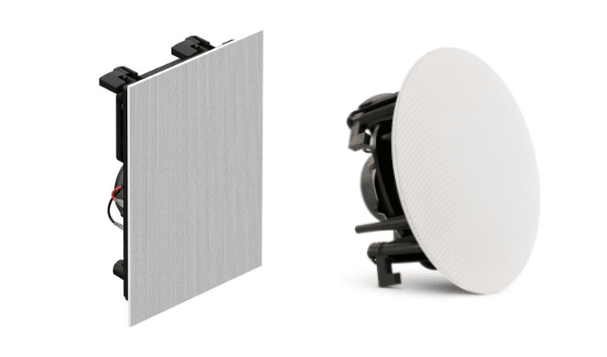
- Pros:
- Completele hides the speakers.
- Ideal for those who want an ultra-discreet setup.
- Doesn’t take up floor space.
- Cons:
- Requires professional installation.
- Difficult to move once installed.
4. Subwoofer and Speaker Underground
Best For: Large Yards, Gardens, or Pool Areas
For a high-performance sound system without visible speakers, consider burying your outdoor speakers or subwoofers underground.
- How It Works: These speakers are beneath the surface, with only the grille or a small part of the speaker visible above the ground.
- Installation: Dig a hole, position the speaker, and cover it with soil or grass. Use waterproof wiring and connectors.
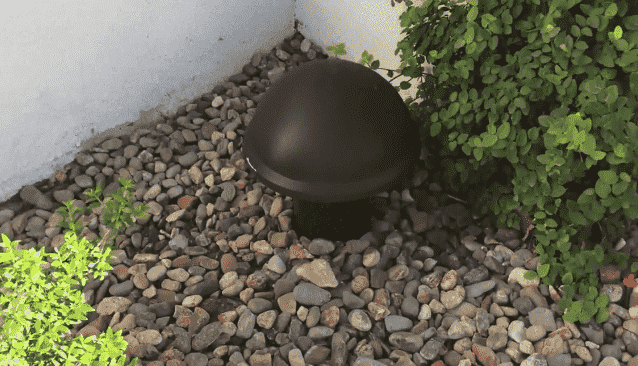
- Pros:
- Minimal visual impact, especially in large yards.
- Full-range sound across a wide area.
- Great for long-range sound distribution.
- Cons:
- Installation can be complex and requires careful planning.
- Expensive, compared to surface-mounted solutions.
5. Speakers Camouflaged as Furniture
Best For: Patios, Pool Decks, and Lounge Areas
Outdoor speakers can also be disguised as furniture pieces, such as stools, chairs, or tables.
- How It Works: Speakers are built into functional outdoor furniture pieces. These are often weatherproof and designed to look like decorative furniture elements.
- Installation: No installation is required other than placing the furniture speakers where you want them in your outdoor living area.
- Pros:
- Adds extra seating or surface space.
- Keeps the sound experience integrated seamlessly.
- No need to worry about wires or unsightly equipment.
- Cons:
- Might limit placement options if you want sound in specific areas.
6. Landscape or Garden Speaker Systems
Best For: Entire Garden or Backyard Areas
Create a surround sound experience across a large outdoor area, landscape speaker systems can be placed discreetly among your plants, shrubs, and trees.
- How It Works: It consists of multiple small speakers, often resembling garden lights or stones., strategically placed throughout the landscape to provide even coverage. The speakers are usually powered by a central receiver.
- Installation: You’ll need to place the speakers in locations where they’ll blend in with plants or the natural environment.
- Pros:
- High-quality, dispersed sound throughout the yard.
- Speakers blend naturally into landscaping.
- Weather-resistant materials ensure durability.
- Cons:
- Requires some planning for placement.
- Expensive than single speaker systems.
7. Speaker Grills Camouflaged with Outdoor Materials
Best For: DIY Projects and Custom Installations
You can design your own speaker enclosures or camouflages using outdoor materials like wood, bamboo, or even outdoor fabrics.
- How It Works: You can install traditional outdoor speakers in custom-built enclosures, and then cover them with weather-resistant materials.
- Installation: This method requires creativity and DIY skill, as you’ll need to build or create a disguise for your speakers.
- Pros:
- Customizable to fit your outdoor aesthetic.
- Creative use of natural materials.
- Cons:
- Labor-intensive and requires some technical skills.
Can Hiding Speakers Reduce Audio Quality?
Yes, hiding speakers can impact audio quality. Rocks or planters can experience sound distortions due to reflections or resonance but some hidden speakers are engineered to minimize these effects. Open placement generally results in better sound performance.
Potential Issues:
- Sound Reflection: Hidden speakers may reflect sound causing distortion.
- Reduced Bass: Enclosed spaces may limit bass performance.
- Imbalanced Sound: Some designs prioritize appearance over acoustics, leading to uneven sound.
High-quality hidden speakers use advanced materials and design features to maintain sound quality. For this, you have to invest in premium outdoor speaker brands.
Hiding Wires for Outdoor Speakers
When setting up the outdoor sound system, hiding the wires can enhance the aesthetics and protect them from weather damage. Although wiring management requires professionalism, following our provided tips can help you.
- Wireless Speakers: The easiest solution is using Bluetooth or Wi-Fi speakers, which eliminate wires. However, these have a range limitations and still require a power source.
- Burying Cables: For wired speakers, you can bury the cables in shallow trenches, to protect from moisture. Use weather-resistant cables.
- Cable Management: Raceways, clips, and ties help organize and conceal wires along walls, fences, or decks.
- Integrated Wiring Solutions: For permanent installations, routing wires through walls or ceilings during construction provides a clean, hidden look.
- Disguising with Landscaping: If you have a garden or landscaped area, use plants, rocks, or mulch to conceal the wires. Ground cover or shrubs can hide wires naturally.
Conclusion:
Hidden outdoor speakers are the perfect combination of great sound and a clean, beautiful space. Whether using rock speakers, planter designs, or in-wall systems, you can integrate audio into your outdoor environment without compromising aesthetics. While some speaker designs may affect sound quality, premium options minimize these issues. With careful installation and creative wiring solutions, can make your sound system hidden.
